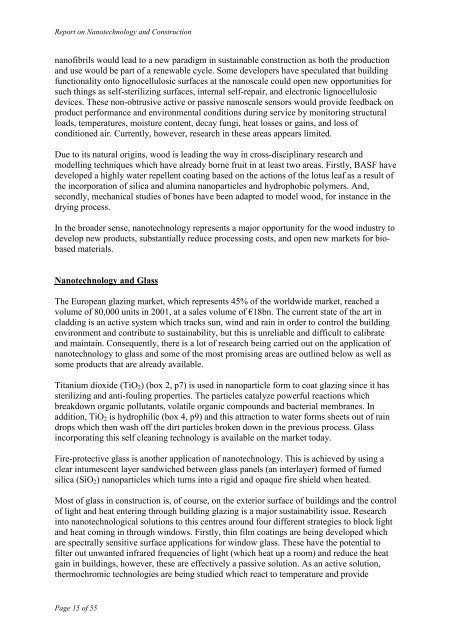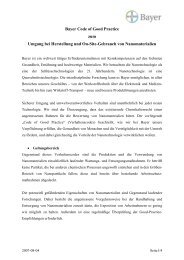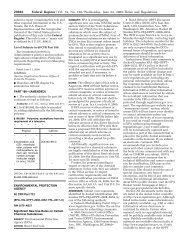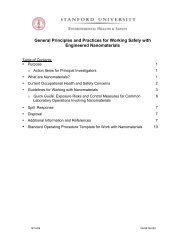Nanotechnology and Construction
Nanotechnology and Construction
Nanotechnology and Construction
You also want an ePaper? Increase the reach of your titles
YUMPU automatically turns print PDFs into web optimized ePapers that Google loves.
Report on <strong>Nanotechnology</strong> <strong>and</strong> <strong>Construction</strong><br />
nanofibrils would lead to a new paradigm in sustainable construction as both the production<br />
<strong>and</strong> use would be part of a renewable cycle. Some developers have speculated that building<br />
functionality onto lignocellulosic surfaces at the nanoscale could open new opportunities for<br />
such things as self-sterilizing surfaces, internal self-repair, <strong>and</strong> electronic lignocellulosic<br />
devices. These non-obtrusive active or passive nanoscale sensors would provide feedback on<br />
product performance <strong>and</strong> environmental conditions during service by monitoring structural<br />
loads, temperatures, moisture content, decay fungi, heat losses or gains, <strong>and</strong> loss of<br />
conditioned air. Currently, however, research in these areas appears limited.<br />
Due to its natural origins, wood is leading the way in cross-disciplinary research <strong>and</strong><br />
modelling techniques which have already borne fruit in at least two areas. Firstly, BASF have<br />
developed a highly water repellent coating based on the actions of the lotus leaf as a result of<br />
the incorporation of silica <strong>and</strong> alumina nanoparticles <strong>and</strong> hydrophobic polymers. And,<br />
secondly, mechanical studies of bones have been adapted to model wood, for instance in the<br />
drying process.<br />
In the broader sense, nanotechnology represents a major opportunity for the wood industry to<br />
develop new products, substantially reduce processing costs, <strong>and</strong> open new markets for biobased<br />
materials.<br />
<strong>Nanotechnology</strong> <strong>and</strong> Glass<br />
The European glazing market, which represents 45% of the worldwide market, reached a<br />
volume of 80,000 units in 2001, at a sales volume of €18bn. The current state of the art in<br />
cladding is an active system which tracks sun, wind <strong>and</strong> rain in order to control the building<br />
environment <strong>and</strong> contribute to sustainability, but this is unreliable <strong>and</strong> difficult to calibrate<br />
<strong>and</strong> maintain. Consequently, there is a lot of research being carried out on the application of<br />
nanotechnology to glass <strong>and</strong> some of the most promising areas are outlined below as well as<br />
some products that are already available.<br />
Titanium dioxide (TiO 2 ) (box 2, p7) is used in nanoparticle form to coat glazing since it has<br />
sterilizing <strong>and</strong> anti-fouling properties. The particles catalyze powerful reactions which<br />
breakdown organic pollutants, volatile organic compounds <strong>and</strong> bacterial membranes. In<br />
addition, TiO 2 is hydrophilic (box 4, p9) <strong>and</strong> this attraction to water forms sheets out of rain<br />
drops which then wash off the dirt particles broken down in the previous process. Glass<br />
incorporating this self cleaning technology is available on the market today.<br />
Fire-protective glass is another application of nanotechnology. This is achieved by using a<br />
clear intumescent layer s<strong>and</strong>wiched between glass panels (an interlayer) formed of fumed<br />
silica (SiO 2 ) nanoparticles which turns into a rigid <strong>and</strong> opaque fire shield when heated.<br />
Most of glass in construction is, of course, on the exterior surface of buildings <strong>and</strong> the control<br />
of light <strong>and</strong> heat entering through building glazing is a major sustainability issue. Research<br />
into nanotechnological solutions to this centres around four different strategies to block light<br />
<strong>and</strong> heat coming in through windows. Firstly, thin film coatings are being developed which<br />
are spectrally sensitive surface applications for window glass. These have the potential to<br />
filter out unwanted infrared frequencies of light (which heat up a room) <strong>and</strong> reduce the heat<br />
gain in buildings, however, these are effectively a passive solution. As an active solution,<br />
thermochromic technologies are being studied which react to temperature <strong>and</strong> provide<br />
Page 15 of 55

















